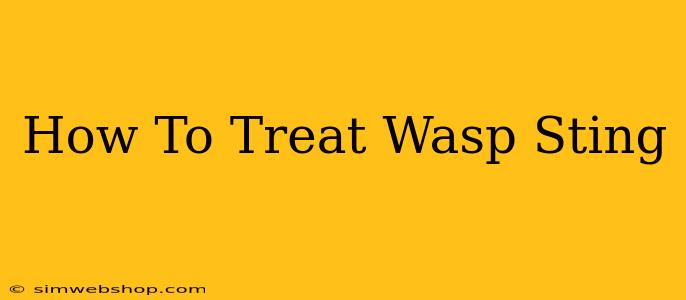Wasp stings are a common summertime nuisance, causing pain, swelling, and sometimes even a serious allergic reaction. Knowing how to treat a wasp sting effectively can make all the difference in managing discomfort and preventing complications. This comprehensive guide will walk you through the steps to take, from immediate first aid to seeking medical attention when necessary.
Immediate Actions After a Wasp Sting
The first few minutes after a wasp sting are crucial. Here's what you should do:
1. Remove the Stinger (If Present):
Unlike bees, wasps can sting multiple times and don't leave their stinger behind. However, if you see any fragments of the wasp's body embedded in your skin, gently scrape them away with a clean, flat object like a credit card or the edge of a knife. Avoid squeezing the stinger, as this can release more venom.
2. Clean the Affected Area:
Wash the sting site thoroughly with soap and water to remove any remaining venom and prevent infection.
3. Apply a Cold Compress:
Applying a cold compress (ice wrapped in a cloth) to the sting for 10-15 minutes at a time can help reduce swelling and pain. Never apply ice directly to the skin.
4. Elevate the Affected Limb (If Possible):
If the sting is on an arm or leg, elevating it above your heart can help minimize swelling.
Home Remedies for Wasp Sting Pain and Swelling
While immediate action is key, several home remedies can help alleviate discomfort:
1. Baking Soda Paste:
Make a paste of baking soda and water. Apply this paste to the sting site. Baking soda is believed to help neutralize the venom's acidity.
2. Apple Cider Vinegar:
Similar to baking soda, apple cider vinegar's acidity can potentially neutralize wasp venom. Apply a diluted solution to the sting using a clean cloth.
3. Aloe Vera:
Aloe vera gel's soothing properties can help reduce inflammation and pain. Apply a small amount of aloe vera gel directly to the sting.
4. Over-the-Counter Pain Relief:
Ibuprofen or acetaminophen can help manage pain and reduce inflammation. Follow the recommended dosage instructions on the packaging.
When to Seek Medical Attention
While many wasp stings can be treated at home, some situations require immediate medical attention:
- Multiple stings: Numerous stings can lead to a severe systemic reaction.
- Difficulty breathing or swallowing: These symptoms indicate a possible allergic reaction.
- Hives or swelling of the face, lips, or tongue: These are classic signs of anaphylaxis, a life-threatening allergic reaction.
- Dizziness or lightheadedness: These symptoms could be indicative of a severe reaction.
- Rapid pulse or drop in blood pressure: These are serious symptoms requiring immediate medical intervention.
If you experience any of these symptoms, seek immediate medical attention. Those with known wasp allergies should always carry an epinephrine auto-injector (EpiPen) and seek immediate medical help after a sting.
Preventing Wasp Stings
Prevention is always better than cure. Here are some tips to minimize your risk of wasp stings:
- Avoid wearing brightly colored clothing and strong perfumes: Wasps are attracted to these.
- Be cautious around sugary drinks and food: Wasps are drawn to sweet substances.
- Don't swat at wasps: This can agitate them and increase the likelihood of being stung. Instead, move slowly and calmly away.
- Keep garbage cans tightly covered: This prevents wasps from foraging near your home.
- Inspect food and drinks before consuming them: Make sure there are no wasps present.
By understanding how to treat a wasp sting and taking preventative measures, you can enjoy the outdoors while minimizing your risk of encountering this common summertime problem. Remember, early treatment and recognizing the signs of a severe allergic reaction are crucial for your safety.

